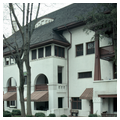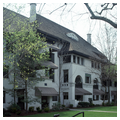Probably the most admired of Frederick Scheibler's many houses and apartments in the city, Old Heidelberg is a twelve-unit, three-story, concrete apartment block with cottage wings, strongly akin to his nearby Linwood Apartments (1907) at McPherson Boulevard and N. Linwood Avenue and The Whitehall (1906) at East End Avenue and Tuscarora Street. Scheibler is seen today as Pittsburgh's local prophet of modernism, especially in his Vilsack Row terrace of eighteen attached apartments (1912; 1659–1693 Jancey Street), with their absence of decoration, uncompromising horizontality, and contrast of solids and voids. A designer unschooled in architecture, he apprenticed with the local Barr and Moser firm and worked in traditional styles until breaking out on his own in 1901. He never left Pittsburgh, but traveled far stylistically. At Old Heidelberg, he used a more decorative treatment of openings and surfaces. The starkness of the white walls and the dramatic back-and-forth massing of the apartment volumes are resolutely modern, but the effect is rendered ambiguous by the pseudothatched profile of the massive, brooding roofs.
You are here
Old Heidelberg Apartments
If SAH Archipedia has been useful to you, please consider supporting it.
SAH Archipedia tells the story of the United States through its buildings, landscapes, and cities. This freely available resource empowers the public with authoritative knowledge that deepens their understanding and appreciation of the built environment. But the Society of Architectural Historians, which created SAH Archipedia with University of Virginia Press, needs your support to maintain the high-caliber research, writing, photography, cartography, editing, design, and programming that make SAH Archipedia a trusted online resource available to all who value the history of place, heritage tourism, and learning.

















